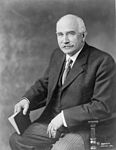1912 Democratic Party presidential primaries
| |||||||||||||||||||||||||||||||||||||||||
| |||||||||||||||||||||||||||||||||||||||||
 | |||||||||||||||||||||||||||||||||||||||||
| |||||||||||||||||||||||||||||||||||||||||
From March 19 to June 4, 1912, voters of the Democratic Party chose its nominee for president in the 1912 United States presidential election.[1] New Jersey Governor Woodrow Wilson was selected as the nominee through a series of primary elections and caucuses culminating in the 1912 Democratic National Convention held from June 25 to July 2, 1912, in Baltimore, Maryland.
Campaign[]
The race was primarily a contest between Woodrow Wilson and Champ Clark. John Burke and Judson Harmon also ran, but they were favorite sons with little appeal outside their home states.
Candidates[]
Nominee[]

Governor
Woodrow Wilson
of New Jersey
Withdrew During Convention[]

Speaker
Champ Clark
of Missouri
Governor
Judson Harmon
of Ohio
Withdrew During Primaries[]

Governor
John Burke
of North Dakota
Results[]
| State | Date | Woodrow Wilson | Champ Clark | Judson Harmon | John Burke |
|---|---|---|---|---|---|
| North Dakota | March 19 | 0.0% | 0.0% | 0.0% | 100.0% |
| Wisconsin | April 2 | 55.7% | 44.2% | 0.0% | 0.0% |
| Illinois | April 9 | 25.7% | 74.3% | 0.0% | 0.0% |
| Pennsylvania | April 13 | 100.0% | 0.0% | 0.0% | 0.0% |
| Nebraska | April 19 | 27.9% | 41.0% | 24.3% | 0.0% |
| Oregon | April 19 | 53.0% | 43.4% | 3.3% | 0.0% |
| Massachusetts | April 30 | 29.9% | 68.9% | 0.0% | 0.0% |
| Maryland | May 6 | 34.3% | 54.4% | 11.3% | 0.0% |
| California | May 14 | 28.5% | 71.5% | 0.0% | 0.0% |
| Ohio | May 21 | 45.7% | 1.3% | 51.7% | 0.0% |
| New Jersey | May 28 | 98.9% | 1.1% | 0.0% | 0.0% |
| South Dakota | June 4 | 35.2% | 32.0%[notes 1] | 0.0% | 0.0% |
| Legend: | 1st place (popular vote) |
2nd place (popular vote) |
3rd place (popular vote) |
|---|
See also[]
- Republican Party presidential primaries, 1912
Notes[]
- ^ The pro-Clark vote was split between two slates of delegates. The first one, labeled "Wilson-Clark-Bryan" received 32% while the second one, labeled "Champ Clark" received 20%. Clark's people accused the latter slate of being a scheme to split the vote. Only the votes received by the Wilson-Clark-Bryan slate are included in this total.
References[]
- ^ Kalb, Deborah (2016-02-19). Guide to U.S. Elections - Google Books. ISBN 9781483380353. Retrieved 2016-02-19.
Categories:
- 1912 United States Democratic presidential primaries







